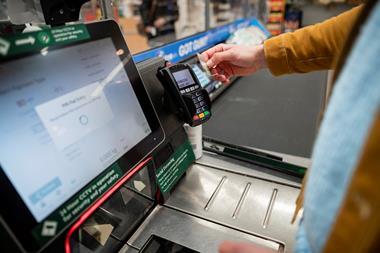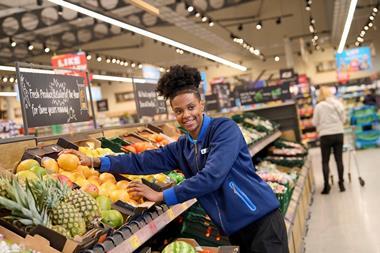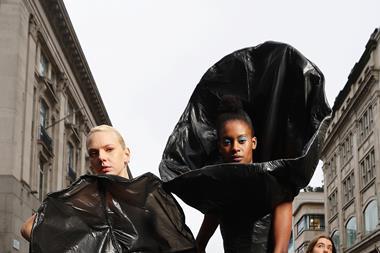The turnaround at Starbucks has involved a more thoughtful approach to growth, says UK MD Darcy Willson-Rymer. Adam Leyland reports
Starbucks is famous for its customer service.
The phenomenon of the dry, decaf, skinny cappuccino was much mocked and much mimicked as the chain developed at breakneck speed following its UK launch 12 years ago.
And then the recession hit. Coinciding almost precisely with the September 2008 arrival of new UK MD Darcy Willson-Rymer, 50 stores were shuttered, as footfall and sales plummeted, amid widespread predictions of coffee-chain carnage.
Fast-forward two years, and Willson-Rymer, sat in one of the new-look Starbucks in Knightsbridge, cuts a more relaxed figure than he did the last time we met. Not surprisingly.
Though the economy is hardly robust, and coffee consumption remains flat in the UK, last week the UK business reported its seventh consecutive quarter of like-for-like sales growth in Q2 (to 4 April).
And Starbucks UK is back in expansion mode: 50 new stores were opened in 2010 alone, with several further openings in 2011, including a modish small neighbourhood store in Covent Garden's Neal Street; a walk-through outlet in Borough High Street; a drive-through in Preston (the first of 12 in 2011); and a 3,000 sq ft "business lounge" in Heathrow's Terminal Five. With two million customers a week, footfall is the highest it's ever been, he adds.
One reason for the turnaround is a new approach to expansion. "The average consumer in the UK drinks 56 cups of coffee per month. We want to understand how many they want to be Starbucks and where," he says.
So, from relentless territorial rollout (the current store count is around 700), Starbucks has moved to "a more thoughtful growth" strategy, says the Canadian-born MD, based not on a numbers game but on meeting consumers' needs. "I don't measure success by the number of outlets. My definition of success is that when a customer leaves our store, their day has been better. If we haven't we've failed. And as we grow, we have to be more loved, not less. So where I build store 701 really matters. It has to satisfy a customer need."
The tie-up with Welcome Break is an example. "Customers said they wanted more coffee on the go. The deal with Welcome Break delivers the Starbucks service in 35 service stations. I can't tell you the number of letters [of thanks] we received after that deal."
Customer need has also determined product development. So, having built the brand, another key component of the turnaround has been to leverage it through better product extensions based on different usages and occasions.
After initially limiting grocery-based brand extensions to a small number of blended bean and ground coffees, in early 2009 it trialled a fancy instant coffee called Via. Despite early scepticism, it was rolled out nationally in Starbucks stores, and has since gone on to gain 4,000 listings in UK grocery outlets, while new blends have raised the number of SKUs from two to seven.
Again, the approach has been further customised for the UK. "The instant coffee market in the UK is quite substantial. Customers were asking for a tin or jar. And Tesco buyers were hearing the same." So Starbucks launched a pocket sized new tin in March, with a natty mini-dispenser, offering consumers 24 servings.
Already a $200m brand worldwide, Starbucks now aspires to develop Via into a $1bn brand through further development. But it's not the only new product development in the burgeoning consumer products group (up 46% globally in Q2).
Starbucks last year launched the first in a range of ready-to-drink iced coffee drinks called Discoveries and Double Shot. Now available in 3,000 points of distribution these 'hot cold drinks' achieved 70% growth, according to Britvic's soft drinks report, making this the fastest growing sub-category within the soft drinks sector.
The latest innovation is a new bottled version of the Starbucks Frappuccino flavoured milks launched in conjunction with Arla. Available in Asda and Morrisons from last month, sales have already received an early boost from the warm weather, and as deals are being finalised with other multiple and independent outlets, Starbucks is expecting 60% weighted distribution by the summer.
Of course, as a global coffee chain, some of the changes introduced in the UK have been imposed from above, as the fabled (and Steve Jobs-like) return of CEO Howard Schultz has inspired a turnaround of the Starbucks business on a global scale. As part of the latest initiative to celebrate the 40th anniversary of Starbucks, for example, an updated logo and smart new mugs were introduced in March.
But Willson-Rymer has been given plenty of licence to fix the business; and indeed it's not the transformation of Starbucks UK that he's most proud of; "it's how we did it".
A number of initiatives, he points out, have either been exclusive to the UK, or inspired by in
"I asked a group of customers and employees how they wanted Starbucks to look at the end of the recession." As well as emphasising how important it was to stick to and amplify its values, "they told me that we needed to reward loyalty; create a nicer environment in which customers could sit and relax over a coffee; and to employ enough staff to serve customers, even during peak periods."
So Willson-Rymer "made a ton of investments in those areas", introducing a card reward scheme that offers an unlimited number of cups of filter coffee for £1, plus an extra shot for free and free wi-fi.
Starbucks also brought in different smaller food items "to make sure you could come in and have coffee and cake for under £3."
And in listening to customers, it was also vital to respond to some very specific local needs, too.
On food, after work started two years ago with a review of ingredients, taking out additives and artificial ingredients, reducing salt, it then looked at range, launching toasted fruitbread, porridge, and other UK exclusives such as Starbucks Petites.
"This is the only market in which you'll find a cheese and Marmite panini," he adds.
Even the stores must be locally relevant, he says. And he's just recruited a design team of five people over the past six months to deliver "the right look and feel based on customer usage".
"The designers now walk the streets, listen to local residents, the local council, to find out what's wanted. It talks to our growth model having evolved in the last couple of years."
Boring stuff
Of course, the turnaround of Starbucks has also involved a review of what Willson-Rymer calls "the boring stuff", like supply chain efficiency. He credits, in particular, a team member who reconfigured waste management arrangements that not only resulted in 95% of waste in store being recycled, but a saving of £700,000.
This initiative "shows everyone can make a difference," says Willson-Rymer. And Starbucks recently rewarded the 9,300 staff with a new bonus-based system that replaced stock options with straight stock. "It's a massive change. Even a part-time barista receives stock."
Starbucks has also introduced a new education programme. You won't be surprised to hear that it, too, is customised, with NVQs in customer service; training in supervisory skills; and, for district managers, courses at Ashridge Business School.
"It's not a sheepdip approach, the courses are tailored. But in making our people more qualified, we believe it will encourage staff loyalty."
Starbucks by numbers
12 - The number of years since Starbucks launched its first store in the UK
717 - The number of UK stores today
100 - The number of licensed stores
50 - Stores shuttered at the onset of the recession. Also the number of stores opened in 2010
7 - The growth in like-for-like global sales in Q2. Also, the number of consecutive quarters of growth for the UK business
2,000,000 - Customers Starbucks UK serves a week, its highest-ever figure
9,700 - UK employees
100 - Staff who've worked at Starbucks for more than 10 years
150 - Head office staff
5 - Designers in the new in-house design team
Starbucks is famous for its customer service.
The phenomenon of the dry, decaf, skinny cappuccino was much mocked and much mimicked as the chain developed at breakneck speed following its UK launch 12 years ago.
And then the recession hit. Coinciding almost precisely with the September 2008 arrival of new UK MD Darcy Willson-Rymer, 50 stores were shuttered, as footfall and sales plummeted, amid widespread predictions of coffee-chain carnage.
Fast-forward two years, and Willson-Rymer, sat in one of the new-look Starbucks in Knightsbridge, cuts a more relaxed figure than he did the last time we met. Not surprisingly.
Though the economy is hardly robust, and coffee consumption remains flat in the UK, last week the UK business reported its seventh consecutive quarter of like-for-like sales growth in Q2 (to 4 April).
And Starbucks UK is back in expansion mode: 50 new stores were opened in 2010 alone, with several further openings in 2011, including a modish small neighbourhood store in Covent Garden's Neal Street; a walk-through outlet in Borough High Street; a drive-through in Preston (the first of 12 in 2011); and a 3,000 sq ft "business lounge" in Heathrow's Terminal Five. With two million customers a week, footfall is the highest it's ever been, he adds.
One reason for the turnaround is a new approach to expansion. "The average consumer in the UK drinks 56 cups of coffee per month. We want to understand how many they want to be Starbucks and where," he says.
So, from relentless territorial rollout (the current store count is around 700), Starbucks has moved to "a more thoughtful growth" strategy, says the Canadian-born MD, based not on a numbers game but on meeting consumers' needs. "I don't measure success by the number of outlets. My definition of success is that when a customer leaves our store, their day has been better. If we haven't we've failed. And as we grow, we have to be more loved, not less. So where I build store 701 really matters. It has to satisfy a customer need."
The tie-up with Welcome Break is an example. "Customers said they wanted more coffee on the go. The deal with Welcome Break delivers the Starbucks service in 35 service stations. I can't tell you the number of letters [of thanks] we received after that deal."
Customer need has also determined product development. So, having built the brand, another key component of the turnaround has been to leverage it through better product extensions based on different usages and occasions.
After initially limiting grocery-based brand extensions to a small number of blended bean and ground coffees, in early 2009 it trialled a fancy instant coffee called Via. Despite early scepticism, it was rolled out nationally in Starbucks stores, and has since gone on to gain 4,000 listings in UK grocery outlets, while new blends have raised the number of SKUs from two to seven.
Again, the approach has been further customised for the UK. "The instant coffee market in the UK is quite substantial. Customers were asking for a tin or jar. And Tesco buyers were hearing the same." So Starbucks launched a pocket sized new tin in March, with a natty mini-dispenser, offering consumers 24 servings.
Already a $200m brand worldwide, Starbucks now aspires to develop Via into a $1bn brand through further development. But it's not the only new product development in the burgeoning consumer products group (up 46% globally in Q2).
Starbucks last year launched the first in a range of ready-to-drink iced coffee drinks called Discoveries and Double Shot. Now available in 3,000 points of distribution these 'hot cold drinks' achieved 70% growth, according to Britvic's soft drinks report, making this the fastest growing sub-category within the soft drinks sector.
The latest innovation is a new bottled version of the Starbucks Frappuccino flavoured milks launched in conjunction with Arla. Available in Asda and Morrisons from last month, sales have already received an early boost from the warm weather, and as deals are being finalised with other multiple and independent outlets, Starbucks is expecting 60% weighted distribution by the summer.
Of course, as a global coffee chain, some of the changes introduced in the UK have been imposed from above, as the fabled (and Steve Jobs-like) return of CEO Howard Schultz has inspired a turnaround of the Starbucks business on a global scale. As part of the latest initiative to celebrate the 40th anniversary of Starbucks, for example, an updated logo and smart new mugs were introduced in March.
But Willson-Rymer has been given plenty of licence to fix the business; and indeed it's not the transformation of Starbucks UK that he's most proud of; "it's how we did it".
A number of initiatives, he points out, have either been exclusive to the UK, or inspired by in
"I asked a group of customers and employees how they wanted Starbucks to look at the end of the recession." As well as emphasising how important it was to stick to and amplify its values, "they told me that we needed to reward loyalty; create a nicer environment in which customers could sit and relax over a coffee; and to employ enough staff to serve customers, even during peak periods."
So Willson-Rymer "made a ton of investments in those areas", introducing a card reward scheme that offers an unlimited number of cups of filter coffee for £1, plus an extra shot for free and free wi-fi.
Starbucks also brought in different smaller food items "to make sure you could come in and have coffee and cake for under £3."
And in listening to customers, it was also vital to respond to some very specific local needs, too.
On food, after work started two years ago with a review of ingredients, taking out additives and artificial ingredients, reducing salt, it then looked at range, launching toasted fruitbread, porridge, and other UK exclusives such as Starbucks Petites.
"This is the only market in which you'll find a cheese and Marmite panini," he adds.
Even the stores must be locally relevant, he says. And he's just recruited a design team of five people over the past six months to deliver "the right look and feel based on customer usage".
"The designers now walk the streets, listen to local residents, the local council, to find out what's wanted. It talks to our growth model having evolved in the last couple of years."
Boring stuff
Of course, the turnaround of Starbucks has also involved a review of what Willson-Rymer calls "the boring stuff", like supply chain efficiency. He credits, in particular, a team member who reconfigured waste management arrangements that not only resulted in 95% of waste in store being recycled, but a saving of £700,000.
This initiative "shows everyone can make a difference," says Willson-Rymer. And Starbucks recently rewarded the 9,300 staff with a new bonus-based system that replaced stock options with straight stock. "It's a massive change. Even a part-time barista receives stock."
Starbucks has also introduced a new education programme. You won't be surprised to hear that it, too, is customised, with NVQs in customer service; training in supervisory skills; and, for district managers, courses at Ashridge Business School.
"It's not a sheepdip approach, the courses are tailored. But in making our people more qualified, we believe it will encourage staff loyalty."
Starbucks by numbers
12 - The number of years since Starbucks launched its first store in the UK
717 - The number of UK stores today
100 - The number of licensed stores
50 - Stores shuttered at the onset of the recession. Also the number of stores opened in 2010
7 - The growth in like-for-like global sales in Q2. Also, the number of consecutive quarters of growth for the UK business
2,000,000 - Customers Starbucks UK serves a week, its highest-ever figure
9,700 - UK employees
100 - Staff who've worked at Starbucks for more than 10 years
150 - Head office staff
5 - Designers in the new in-house design team














No comments yet